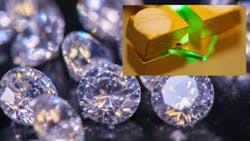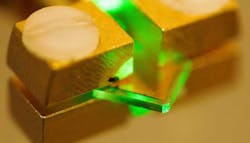Diamonds Could Replace Silicon in Some Semiconductors
As electronic engineers are reaching the physical limits of silicon for semiconductors, researchers at Lawrence Livermore National Laboratory (LLNL) are looking at an alternative material—diamond—as an ultra-wide bandgap semiconductor.
Diamond is known to have better carrier mobility and thermal conductivity, the most important properties for powering electronic devices.
The team explored properties of synthetically made diamonds that are higher quality than naturally occurring ones. They are made using chemical vapor deposition (CVD). “In electronics, you want to start with a pure material so you can so you can mold it into a device with the properties you want,” says LLNL physicist Paulius Grivickas.
In photoconductive devices, electronic engineers get the best combination of conductivity and frequency response by introducing impurities, which control carrier recombination lifetimes. Researchers found that a less-expensive, easier alternative for diamonds is to use electron irradiation, which spawns recombination defects by knocking lattice atoms out of place.
“We decided to take pure high-quality CVD diamond and irradiate it to try and tailor its carrier lifetime,’” says Grivackas. “Eventually, we nailed down the understanding of which irradiation defect is responsible for carrier lifetimes and how this defect behaves under annealing at the right temperatures.”
Photoconductive diamond switches produced this way could be used in the power grid to control current and voltage surges, which can destroy equipment. Current silicon switches are big and bulky and, according to Grivickas, diamond-based ones can accomplish the same thing with a device that fits on the tip of a finger.
Livermore engineers worked with researchers from Vilnius University in Lithuania, Belarusian State University and the National Academy of Sciences in Belarus.

